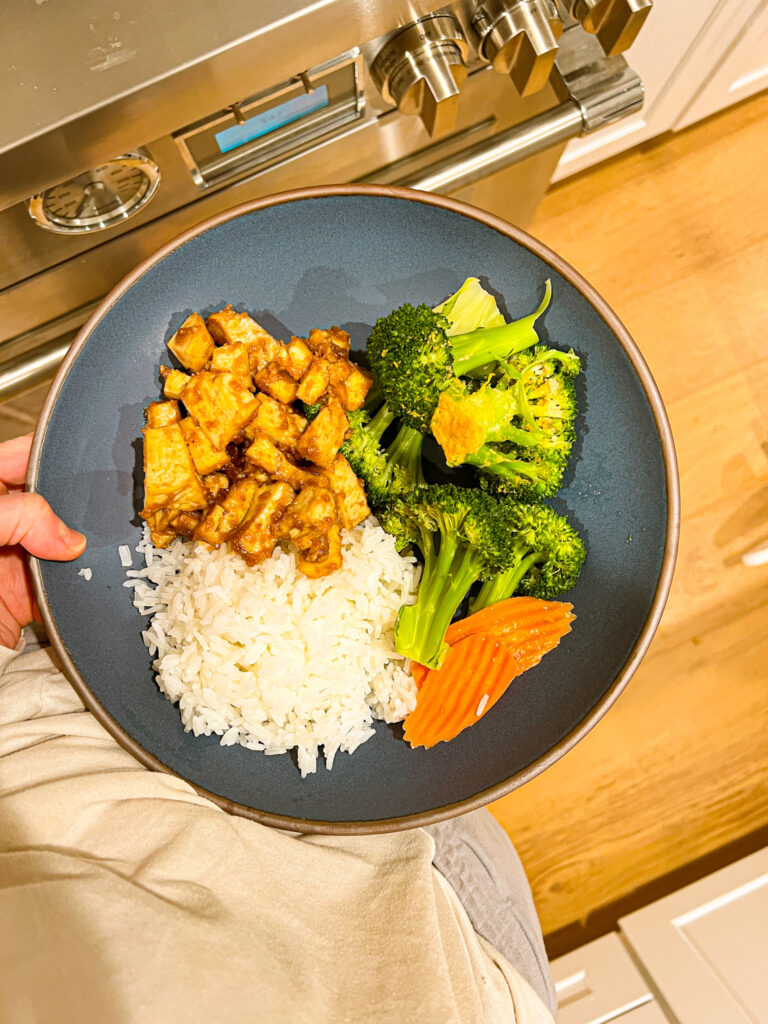
Vegan Stuffing Substitutions
There are a few essential ingredients you should include when making stuffing. Here they are and the vegan substitution for each. All subs can be made on a 1:1 ratio (in general).
Key: Traditional Ingredient - Vegan Substitute
1. unsalted butter - vegan buttery spread (example: Earth Balance brand)
2. onions - no sub required
3. celery - no sub required
4. fresh and/or dried herbs (thyme and sage) leaves - no sub required
5. chicken broth - vegetable broth (low-fat)
6. white cubed bread, day-old/stale - cubed bread (white/wheat/spelt), day-old/stale
*note: you may need to use a bit less bread in your recipe if you are using a whole wheat/high fiber bread source (compared to white sandwich bread). Higher fiber bread will not bake-down as much as white will.
7. salt/pepper - no sub required (less salt may be required so salt to taste)
8. flat leaf parsley - no sub required
Non-Essential Ingredients - Common Flavor Add-ins
9. bacon - tempeh bacon
10. sausage - seitan or vegan sausage by Field Roast brand, (Apple Sage flavor)
11. nuts - no sub required
12. milk/cream - soy/hemp/oat milk and soy creamer
13. dried and/or fresh fruit - no sub required
14. mushrooms - no sub required (mushrooms are another great vegan sub for 'savory meaty flavors'
15. chestnuts - no sub required
16. sugar/honey - vegan raw sugar/agave/maple syrup
17. eggs (thickener) - squash purees/apple or pumpkin butter/nut meal/silken tofu
18. cornbread stuffing - vegan cornbread day-old
The Big Question: Where do I stuff my vegan stuffing?
Answer: There are several ways to 'stuff' your vegan stuffing, some are easy and some are bit more labor/time intensive:
1. Un-Stuffed. You don't need to stuff your stuffing. Baking it in a dish will work fine. How-to: Simply lay your stuffing flat in a deep casserole dish. Line the bottom of the dish with a few tablespoons of olive oil and veggie broth to keep the stuffing super moist. Cover with foil - very tightly. Poke a few vent holes for steam. Stick in the oven to bake for at least 20 minutes. If you are using this "unstuffed" method, I'd recommend adding extra veggie broth to your recipe to prevent dryness. Use your eyes and taste-testing to judge. Stuffing should go into the oven moister than you want it to come out. Another 'moisture option' is to line the casserole dish with a squash puree. You can even make it easy on yourself and use canned butternut squash or canned sweet potatoes. A thin layer will assist in adding moisture as your stuffing bakes. Canned is OK because it is more about effecting the moisture rather than effecting the flavor.
2. Squash Stuffed. I love this idea. In fact, I experimented with about 3 variations of squash and loved them all. The idea: every diner will get their own ½ of a stuffing-stuffed squash. Or if you are using mini squash you can give every diner their own stuffed squash. You can also use the small squash as serving bowls to simply scoop out portions. I experimented with carnival, acorn, white acorn and banana squash. I really loved how the white acorn squash came out the best. Just be sure to use a squash that you can easily hollow out (remove seeds) from via a top slice. Butternut squash is not a correct shape for this type of recipe.
Basic Instructions: 1. Wash squash thoroughly in hot water. 2. Slice out top and remove seeds as if you were carving a pumpkin. Rinse/dry insides. 3. Drizzle/rub a bit of oil/salt/sweetener (maple/agave/sugar) inside the squash. 4. Place squash and cap on a baking sheet and roast in a 400 degree oven until tender, but not mushy or falling apart. Edible at this point, pre-stuffed. 5. Remove from oven, stuff with cooked stuffing (prepared on your stove top). Pack in tightly. Keep top squash caps for garnish. 6. Place back in the oven for at least 20-30 minutes to bake until perfectly tender. Wrapping squash in foil is optional-this keeps it super moist, but will soften the squash skin a bit. (Foil wrapping is not a good idea if your squash is thin-skinned. However, it is a good idea for thick skinned squash like acorn.)
3. Pumpkin Stuffed. Same idea as above, only you can slice the pumpkin into two large 'bowls' and everyone cam scoop their portion directly from the pumpkin. Be sure to use a more generous amount of oil/sweetener (I love maple syrup) and salt on the inside of the pumpkin to bring out the flavor. Pumpkin is naturally much duller in sweetness and flavor than other winter squash.
4. Filo Purses. If you like working with filo dough you're in luck, because it comes in vegan sheets! Just check Whole Foods freezer section. Simply follow the directions on the box and provide every diner their own wrapped up purse of stuffing. I like to tie my purses with long thick strands of parsley stems. You can also use water-soaked twine, but an edible string is my preference.
Tips:
*Try to use a 'healthier' bread blend. Yes plain white sandwich bread will give you a more traditional stuffing, but not a lot of nutrients or fiber. Try getting creative with 6 grain, seeded, whole grain, wheat, spelt, quinoa and even vegan cornbread. You're stuffing will have a more complex flavor. Plus, healthier bread base, healthier stuffing.
*How much buttery spread? Traditional stuffing recipes call for a lot of butter. Some recipes call for a whopping 12-15 tablespoons of butter. And since stuffing turns out to be such a dense item, a lot of butter can infuse into even a small serving. Instead, halve the butter amount (or use even less) and add in a few tablespoons of a healthy fat oil like olive/canola/walnut/hemp or grapeseed oil. The great thing about stuffing is that you can easily adjust the ingredients to meet your flavor requirements. Depending on what ingredients you use, you may find that very minimal added-fat is required.
For example: using a few tablespoons of butternut squash puree and a nice helping of chopped nuts will provide your recipe with plenty of body and nut-infused fat flavor. Using a high quality or homemade veggie broth can also help with the flavor/moisture balance without making excessive added buttery spreads/oils a necessity for flavor. Use your taste-testing skills and prepare your stuffing the way you and your guests will love it best. Just remember you can always add fats to a recipe, but you can't remove them! So taste as you go, and start will less added 'buttery spread/oils' than you think you need.
*Health Tip: More Veggies Please! I always turn up the amount of veggies I put in my stuffing. Celery, onions, parsley. Add more of the good healthy stuff 'in' and your resulting recipe will be heartier in veggies and healthier in the end. Turn up the veggie add-ins!
*Stale Bread? The reason most stuffing recipes call for day old or stale bread is because stale bread is more dried out and will absorb more flavors than fresh moist bread. The drier the bread the more moisture you will need in your recipe. That is why you really need to take into account the type of bread you are using compared to what the recipe calls for. If the recipe calls for day old bread and you are using dried bagged bread cubes (not recommended) you will need to add more moisture so that you thoroughly saturate your cubes. An vice-versa.
If you are using fresh bread (which actually isn't as 'bad' as most recipes say it is) just use a bit less broth so you don't sog up your stuffing. Note: I have used 'nearly fresh' bread several times in my stuffing recipes and actually enjoy the flavor. The stuffing turns out super-moist and the flavor of the bread really shines through. Dried bread cubes can sometimes be devoid of 'bread flavor'.
*Vegan Add-Ins. It's generally easy to find vegan ingredients for your stuffing. Vegetables, nuts, dried fruit, fresh fruit, mushrooms, spices, herbs are all fair game. However when it comes to ingredients like bacon, sausage and eggs you will have to put your vegan thinking cap on. See the ingredient subs above and think about what 'meat' substitutions you have tried, tasted and enjoyed in everyday life.
My Stuffing Rule of Thumb:
"If it tastes good on a sandwich, it will taste good as a stuffing recipe."
More on this: Imagine putting your flavors between two pieces of bread. If those flavors are hearty, flavorful and successful as a 'sandwich' they will probably work as stuffing. Example: blueberries and tempeh bacon would probably make a weird sandwich, thus a weird stuffing. (By weird, I mean odd tasting) However, sausage, apple and chestnut would make a yummy sandwich, thus a yummy stuffing.
So those are Stuffing Basics 101. Next up, I'll be posting a trio of my fave stuffing recipes...














